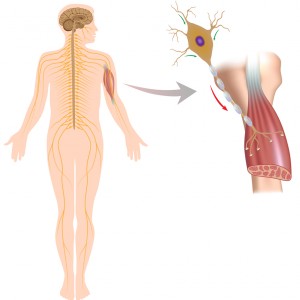Researchers Publish Case Study on Coexisting Spinal Muscular Atrophy and Type 1 Diabetes Mellitus
Written by |

The first report of co-existing spinal muscular atrophy (SMA) with diabetes mellitus type 1 appeared in the journal Acta Biochemica Polonica, February 12, 2015. The report, titled “Coexistence of type 1 diabetes mellitus and spinal muscular atrophy in an 8-year-old girl: a case report,” came from the Medical University of Gdańsk, Poland.
 SMA is an infrequently occurring autosomal recessive genetic disease in which progressive loss of muscular strength occurs, leading to eventual death. The disease occurs in one in 10,000 people and is characterized by degeneration of motoneurons in both the spinal cord and cranial nerves.
SMA is an infrequently occurring autosomal recessive genetic disease in which progressive loss of muscular strength occurs, leading to eventual death. The disease occurs in one in 10,000 people and is characterized by degeneration of motoneurons in both the spinal cord and cranial nerves.
Diabetes mellitus type 1 is an autoimmune metabolic disorder characterized by impaired insulin synthesis.
Specific spinal cord neurons are lost in SMA, which causes weakness of the limbs and muscle degeneration. This leads to loss of voluntary muscle movement. SMA is most commonly caused by a mutation of the SMN1 gene on chromosome 5. The age of SMA onset, symptoms and rate of progression varies — the younger the onset, the more severe the symptoms. SMA is classified into types 1 through 4 to account for the variability in symptoms and onset age.
The case report, led by Anna Borkowska, described an 8-year-old girl suffering from SMA and type 1 diabetes. The authors described the symptoms of the diseases, as well as challenges with clinically diagnosing the two conditions in the same person.
In the case described, SMA was diagnosed at the age of 5 months, and confirmed using genetic testing, demonstrating mutations in the SMN (survival of motoneuron) gene. Three months later, the child was placed on a respirator with a feeding tube.
[adrotate group=”4″]
The researchers described symptoms including “digestive disorders and hemorrhaging from the digestive tract were present. It may be assumed that tachycardia additionally epitomized the pain and/or dehydration.”
The authors further noted, “Both SMA and DM1 are relatively rare diseases and the probability of their co-existence is very low. However, due to the development of medicine, e.g. availability of artificial ventilation, life expectancy of patients with SMA improves. In such circumstances it could be expected that these two rare diseases (both SMA and DM1) might be diagnosed in one individual more often. To the authors’ knowledge, this is the first publication.”
Because of improved medical care for both SMA and DM1, researchers cautioned that co-existing medical problems should be considered and evaluated, explaining, “In severely and chronically ill patients, new pathological symptoms should initiate a differential diagnosis of another, coexisting disease.”






